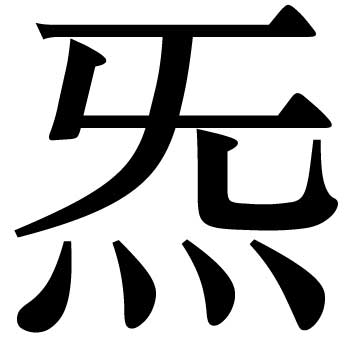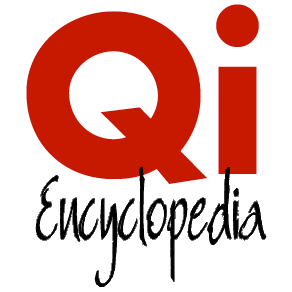The Daoist Character for Qi
By Ken Rose

A special character unique to Daoists texts and talismans.
 : This is a special character found usually in Daoist texts and talismans. It has the same basic meaning and is pronounced the same as qi : This is a special character found usually in Daoist texts and talismans. It has the same basic meaning and is pronounced the same as qi  , though obviously it is a different perspective or way of looking at qi...or why bother with a special character? Those unfamiliar with Chinese characters can misinterpret this character. What might look like the conjunction of nothing and fire , though obviously it is a different perspective or way of looking at qi...or why bother with a special character? Those unfamiliar with Chinese characters can misinterpret this character. What might look like the conjunction of nothing and fire ( ( takes the shape of those four dots at the bottom of the character when it is used as a combining element in characters) is actually the meeting place of a more complex character...no pun intended... takes the shape of those four dots at the bottom of the character when it is used as a combining element in characters) is actually the meeting place of a more complex character...no pun intended...
 Wu is indeed the simplified form of Wu is indeed the simplified form of wu, but it was also an ancient character that had the same significance, i.e., nothing, negation, absence of, etc. However, wu, but it was also an ancient character that had the same significance, i.e., nothing, negation, absence of, etc. However, is not, precisely the component of is not, precisely the component of  . If you look closely you'll see an additional vertical stroke. The component of . If you look closely you'll see an additional vertical stroke. The component of  is ji is ji . Compare the two side by side . Compare the two side by side   , and it is clear. Among the treacheries of Chinese written language, one of the most treacherous is the fact that the addition or deletion of a single stroke or dot can utterly change the meaning of a character. Pity the poor scribes who struggled endlessly with a language requiring such attention to detail. , and it is clear. Among the treacheries of Chinese written language, one of the most treacherous is the fact that the addition or deletion of a single stroke or dot can utterly change the meaning of a character. Pity the poor scribes who struggled endlessly with a language requiring such attention to detail.
The bottom component is fire, so we don't need to focus too much on that aspect of the character, except to point out that here in  we definitely encounter the metaphoric or metaphysical meaning of fire, as it is understood as a member of a set of such metaphor known as wu xing we definitely encounter the metaphoric or metaphysical meaning of fire, as it is understood as a member of a set of such metaphor known as wu xing  or five phases, elements, agents, and so on. We'll come back to the implications of the presence of fire in or five phases, elements, agents, and so on. We'll come back to the implications of the presence of fire in once we have examined once we have examined  . .
What does ji mean? Well, it's a fairly rare character that means...something stuck in your throat, or getting something stuck in your throat, or feeling like there's something stuck in your throat... or there might be or could be.
Based upon oral teaching I received in China from Daoist monks on Qing Cheng Mountain outside of Chengdu I believe that in this character what we're seeing is an encoded instruction about the tongue and breathing. The tongue, in qi cultivation practices, is often placed on the roof of the mouth. In this position, pressing gently upwards and forwards into the back of the top teeth, it pulls the throat open a slight bit...just enough to ensure the free passage of any saliva that might fill the mouth during practice. This saliva is a treasure. what we're seeing is an encoded instruction about the tongue and breathing. The tongue, in qi cultivation practices, is often placed on the roof of the mouth. In this position, pressing gently upwards and forwards into the back of the top teeth, it pulls the throat open a slight bit...just enough to ensure the free passage of any saliva that might fill the mouth during practice. This saliva is a treasure.
When the character is read in this way we can see it as a mnemonic for the notion of the union of fire and water, such as is sought in alchemical techniques and methods in order to obtain the ephemeralization of essence, i.e., refining jing into qi, which is the second step of an ancient alchemical formula still taught and practiced by Daoist novitiates.
Daoists considered the world as a manifestation of the Great Void, Tai Xu  , and this special qi , and this special qi  was a vital ingredient in Daoist formula meant as efforts to find the Elixir of Immortality, dan was a vital ingredient in Daoist formula meant as efforts to find the Elixir of Immortality, dan , which we associate with the location and practices known under the rubric dan tian , which we associate with the location and practices known under the rubric dan tian  . In this context . In this context can be considered as the main way station on the dao of returning to the Great Void can be considered as the main way station on the dao of returning to the Great Void  . .
Thus  emerged as a special Daoist term, found in magical inscriptions, talismans, and accompanying texts. The aim of these texts and talismans lay often in the domain of self-accomplishment and self-refinement. And the flavor of this character emphasizes that it emanates from an interior realm in which the body's innate treasures serve as the primary ingredients. emerged as a special Daoist term, found in magical inscriptions, talismans, and accompanying texts. The aim of these texts and talismans lay often in the domain of self-accomplishment and self-refinement. And the flavor of this character emphasizes that it emanates from an interior realm in which the body's innate treasures serve as the primary ingredients.
| 

